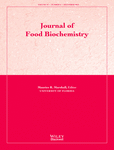Type 2 Diabetes Relevant Bioactive Potential of Freshly Harvested and Long-Term Stored Pears Using in vitro Assay Models
Abstract
ABSTRACT
Fresh pear consumption could provide health benefits by reducing the risk of chronic diseases such as hyperglycemia linked to type 2 diabetes. This in vitro study investigated the phenolic-linked antihyperglycemia bioactive factors in aqueous and ethanolic extracts of peel and pulp from eight different freshly harvested and long-term stored pear varieties. Total soluble phenolics, 2,2-diphenyl-1-picrylhydrazyl radical scavenging-based antioxidant activity and associated in vitro alpha-glucosidase, alpha-amylase and angiotensin I-converting inhibitory activities were analyzed. Peel extracts had higher total soluble phenolic content and related antioxidant capacity than pulp extracts. Comice variety had the highest total phenolic contents with positive correlation to total antioxidant activity. Aqueous pulp extracts had high alpha-amylase inhibitory activities with no correlation to phenolic content. However, the peel ethanolic extracts had the highest alpha-glucosidase inhibitory activity with positive correlation to total phenolics. This research provides the biochemical rationale for further clinical studies to include pear as part of healthy diet.
PRACTICAL APPLICATIONS
Using in vitro structure-function relevant bioassays to screen a range of fruits and vegetables helps to develop biochemical rationale to target and strategize the increased use of these fresh fruits and vegetables for better health and wellness. Pears, because of their phenolic bioactives, have potential to be included as a part of a comprehensive diet for managing early stages of hyperglycemia linked to type 2 diabetes. This study provides foundation for screening of pears for improving dietary strategies for managing this chronic disease and can be the biochemical rationale for further clinical studies.




